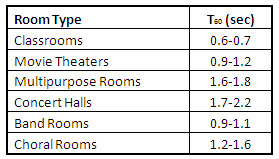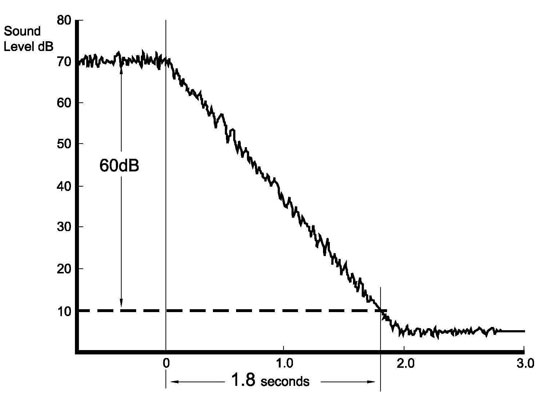Noise Control and Room Acoustics in Building Design
Absorption coefficient
The sound absorption coefficient describes the ability of a material to scatter or diffuse sound expressed as a fraction of incident sound. The sound absorption coefficient is frequency-specific and ranges from 0.00 to 1.00. For example, a material may have an absorption coefficient of 0.50 at 250 Hz, and 0.80 at 1,000 Hz. This indicates that the material absorbs 50 percent of incident sound at 250 Hz, and 80 percent of incident sound at 1,000 Hz. In some cases, the coefficient can exceed 1.00. The arithmetic average of absorption coefficients at mid-frequencies, 250 to 2000 Hz, is the noise reduction coefficient (NRC). It is worth noting that the NRC measurement does not include lower frequencies which are important in many applications. NRC should be considered a method of broad comparison for various sound absorptive materials. Measurements are done according to a standard test method such as ASTM C423.
 |
Desired reverberation time (T60)) varies according to the space. Provided by Kinetics Noise Control |
Room reverberation
Reverberation levels are controlled by the room shape and volume and by adding absorptive material content in the room.
T 60 = .049 V/A
T 60 = Reverberation time (60 dB decay) in seconds
V = Room volume, cubic feet
A = Total room absorption in Sabins
Achieving sound control
In order to select the most effective sound control building system and materials, design professionals are well served by consulting an acoustical engineer whenever acoustic performance is highly important to the project. Addressing the issue during the design stage, yields the most economical and effective solutions. Leading manufacturers typically provide specifications and product performance and fire test reports on their web sites. They also can easily import product details into specifications, documents or plans in AutoCAD, REVIT (BIM) and PDF format.
The key areas for achieving sound control include:
* Finishing Treatment and Surface Shaping within Rooms.
- Absorption
- Reflection
- Diffusion
* Sound isolation between rooms
- Airborne: speech, music, noisy HVAC equipment, air traffic are some examples.
- Structure-borne: footfalls, carts or furniture moving on floor, fitness activity & equipment on floor, adjacent railway or parking garage.
It should be noted that for A/V systems or electronic sound reinforcement to be effective, the room should first have the required sound control treatment.

|
Increased absorptive materials and reduced reverberation improves speech clarity and intelligibility Provided by Kinetics Noise Control |









